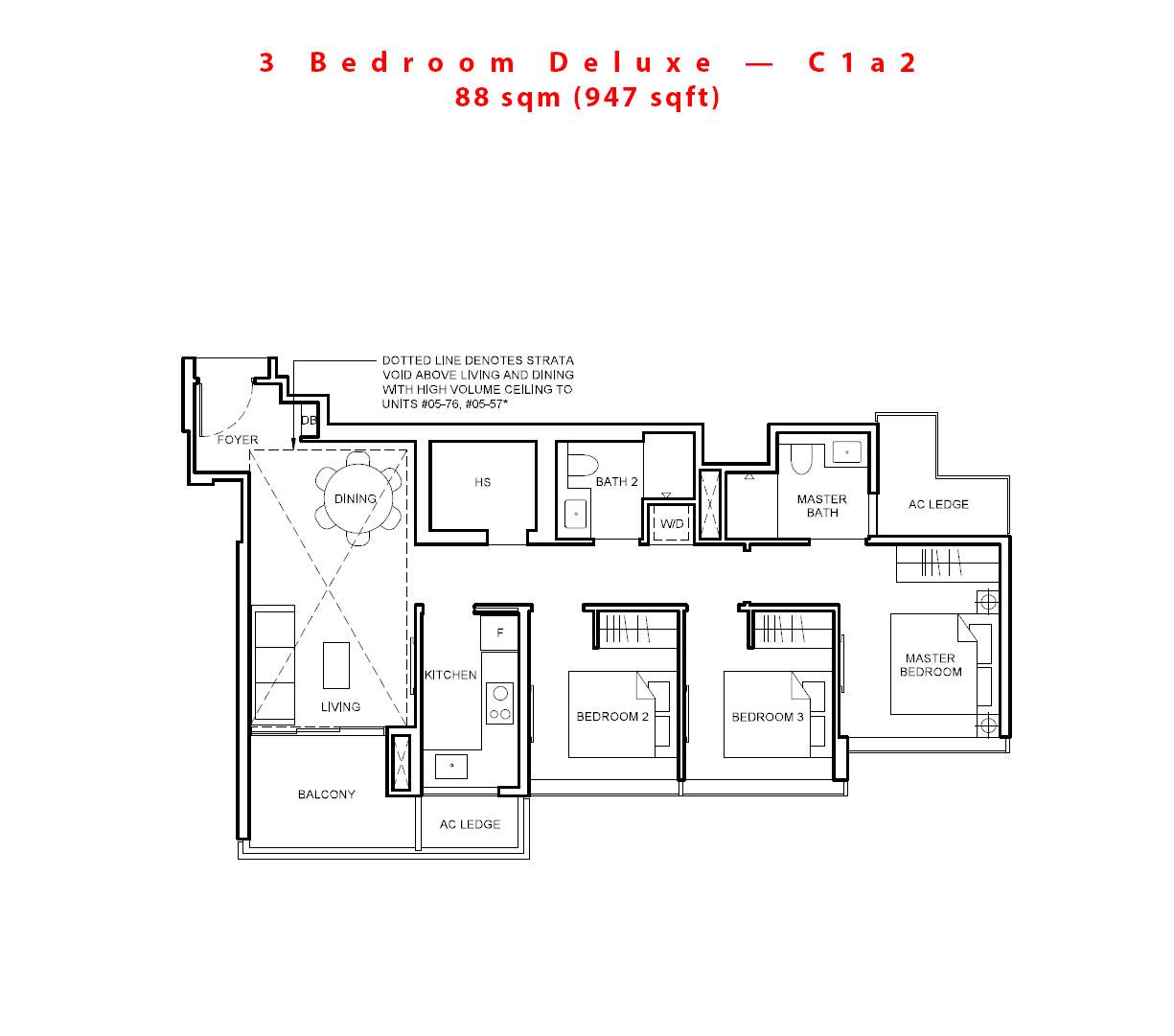Should you rent to multiple tenants or a master tenant?

You have your property all ready to rent out. You’ve reviewed the listing photographs, you’ve read the rules twenty times over, and you’ve gone through the Tenancy Agreements you’re going to use.
But if you’re like most new landlords, you’ll freeze the first time a property agent asks you “how do you feel about having two or more different tenants?”
Sometimes, you just can’t find a single tenant who can foot the whole bill.
Perhaps it’s due to Covid-19 and many expatriates flying home; or maybe it’s just the demographic that your property calls to (e.g. separate student tenants are more common if your property’s in One-North, or near some other University).
Here’s a rundown of what you need to consider:
Adding another tenant can increase rental income, without too much incremental cost. For example, let’s consider a three-room floor plan at the upcoming Forett @ Bukit Timah:

Rental in this location (Bukit Timah) is about $3,500 to $3,700 per month, for a unit of this size. For renting a single room however, rates range from $900 to $1,200 per month.
In this example, let’s say you manage to rent out the two bedrooms at $1,200 each. You could then rent out the master bedroom for $1,600; perhaps justifying the price by keeping the master bathroom exclusive to the tenant of the master bedroom.
This would raise your total monthly rental income to $4,000. Assuming the utilities are paid by the tenants, this doesn’t come at much incremental cost.
(There are some added costs, such as the extra time taken to find more tenants, and to handle the book-keeping).
Rentability refers to how quickly you can find willing tenants. This is the main reason that many landlords are advised to go for two-bedders over one-bedders.
A good example of this is Marina One Residences , which a lot of tenants would love as it’s in the Marina Bay area. The problem is that, at around $5.30 psf, a two-bedder (969 sq. ft.) would cost around $5,136 per month.
Consider, however, if it were rented to two separate tenants. If you were to rent the same unit for, say, $2,600 per month to each of them, this would be more budget friendly; it would increase the prospective pool of tenants.
When renting to a single master tenant, your rental income immediately falls to zero when the tenant leaves.
With multiple tenants however, it’s probable that not all tenants will leave at once. Even if one or two rooms are vacant, chances are you’ll still have at least one tenant providing some rental income.
One strategy among landlords is to ensure the interest-portion of the home loan is always covered by a tenant.
For example: Say your loan repayment is $3,900 per month. $2,800 per month goes toward paying down the principal, while $1,100 goes toward your home loan interest.
If you can ensure that you always make at least $1,100 from rent, you can still come out ahead even if you’re not getting full rental income (as you’re effectively “borrowing for free” when you don’t pay interest on a loan).
However, do note that you may not get your full rental at the start, unless all the different tenants come in at once.
Multiple tenants can sometimes exclude one another. For example, say you have a tenant who has a pet. This would automatically exclude other tenants who dislike animals, have allergies, etc.
In a worse case scenario, some tenants may even get into disputes with each other, causing one or the other to leave. This will not be a problem you have to deal with, if you just have one master tenant.
If anything, this is usually one of the biggest drawbacks to renting out to multiple tenants. It can be time wasting to have to mediate in tenant conflicts, and for some landlords, just not worth their time.

A greater degree of book-keeping is involved, as you need to collect your rent from multiple tenants. These are likely to be due at different times, so you’ll need a system to track the dates.
Damage to common areas is a sticky issue. If there’s damage to the living room furniture, for instance, will the cost be partially borne by every tenant’s security deposit?
Some tenants may object to this, if they feel they weren’t responsible. The same goes for damage to white goods, such as laundry machines and refrigerators.
The dispute resolution methods for these should be spelled out in writing, such as in the Tenancy Agreement.
You can have up to six unrelated tenants renting your property; but your property will still use the same water and electrical meter.
Simply dividing the cost among tenants may be unfair, as some will use more water and power than others (e.g. one tenant using the property as their home office, while another is a student who is rarely home for most of the day).
As this is always a potential sticky point for unrelated tenants, here are 3 possible ways you could manage this:
There’s definitely no right or wrong here (or the most fair), but you’ll need an arrangement that pleases everyone. Again, make sure the rules are in writing, to avoid complications later on.

A single master tenant can mean the whole unit is rented to one family; it can also mean there’s a single tenant, who sublets the other rooms with your permission.
In either case, the master tenant is the one who puts up the security deposit, and is responsible for monthly rent payments. This greatly simplifies things for the landlord, as there’s only one person to collect from.
For example, if you have three students on the property, you would usually have to collect rent from all three of them.
If one of them is the master tenant, you would only need to collect from the master tenant alone (it’s up to the master tenant to chase the others for their share).
The same goes for utilities and damages. The master tenant pays for it, and you don’t need to bother about how everyone else splits it.
This is not always true; but in general, families or individual tenants tend to be the ones looking for longer rental leases.
Tenants who lease rooms often don’t intend to stay for long – you’ll get more people on extended business trips, students who have flown over to complete their final year in school, etc.
A common pattern is for newly arrived foreigners to rent a room for a short time first (e.g. the minimum of six months).
Later, when they’ve familiarised themselves with Singapore or the family flies over, they move and rent a bigger place for a longer period.
Families or individual tenants, who rent out a whole unit for a long time, may not mind if a rental property is unfurnished.
Some may even prefer it, as they might want to furnish it to their own needs (e.g. some families might want a room as a nursery if they’re expecting a child, and some individual tenants want the dining room for other purposes if they always eat out).
[[nid:502245]]
This can help a landlord’s bottom line, as they need to spend less on furnishing. Some landlords rent out unfurnished or partially furnished units to the first tenant, and then buy over – or are even given – the furnishings when the tenants fly home.
(Most tenants will try to sell their furniture second-hand once they depart for home anyway, and just buying over from them is convenient as you don’t even need to move things).
Multiple individual tenants, however, often prefer units that are fully furnished at the outset. If they’re renting a room for six months to a year, for example, they probably won’t want to spend money on buying the desk, study table, etc. themselves.
Some landlords dislike the idea of rental income coming in piecemeal (e.g. one or two rooms rented out, then a third room rented out after only two or three months).
They would rather have all the rent come in right away, so they don’t need to maintain having a listing for the final room; especially if they pay for the listing themselves (they may not use a property agent).
They may also dislike inconsistent rental income, which might rise and fall as some tenants leave and others stay. This is, however, a mixed blessing; see point 3 about having multiple tenants.
If you’re a hands-on landlord, having multiple tenants may be preferable. Renting out room-by-room can help you raise rental income, and it prevents situations where you’re generating no rent at all.
However, it’s a time-consuming process, and you do need to follow up with each tenant individually.
If you don’t have time to mediate between tenants, track your listing and responses, etc., then renting to a single master tenant is the better option.
That being said, the nature and location of your property may dictate which is best. Dual-key units, for instance, are made to be rented out to more than one family (see our previous article on dual-key floor plans ); most single families won’t see the need for two kitchens in their rental unit.
The location of your property also matters. In a family-oriented neighbourhood like Pasir Ris, for instance, you may simply find that more tenants are looking to rent as a family.
This article was first published in Stackedhomes.